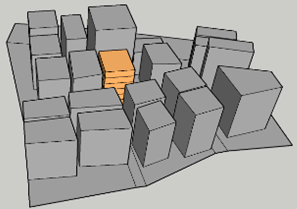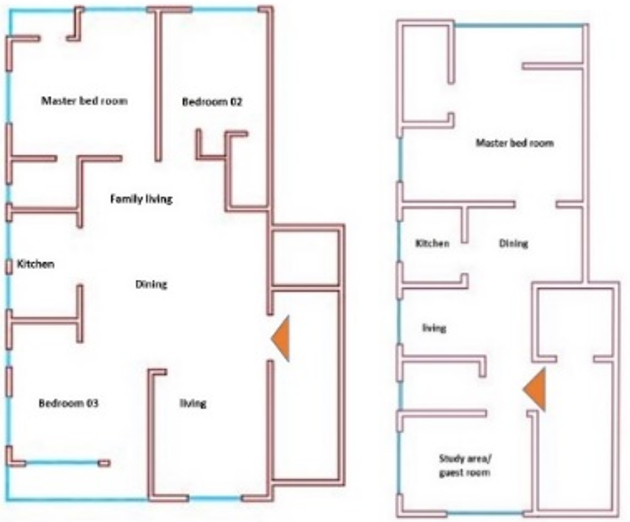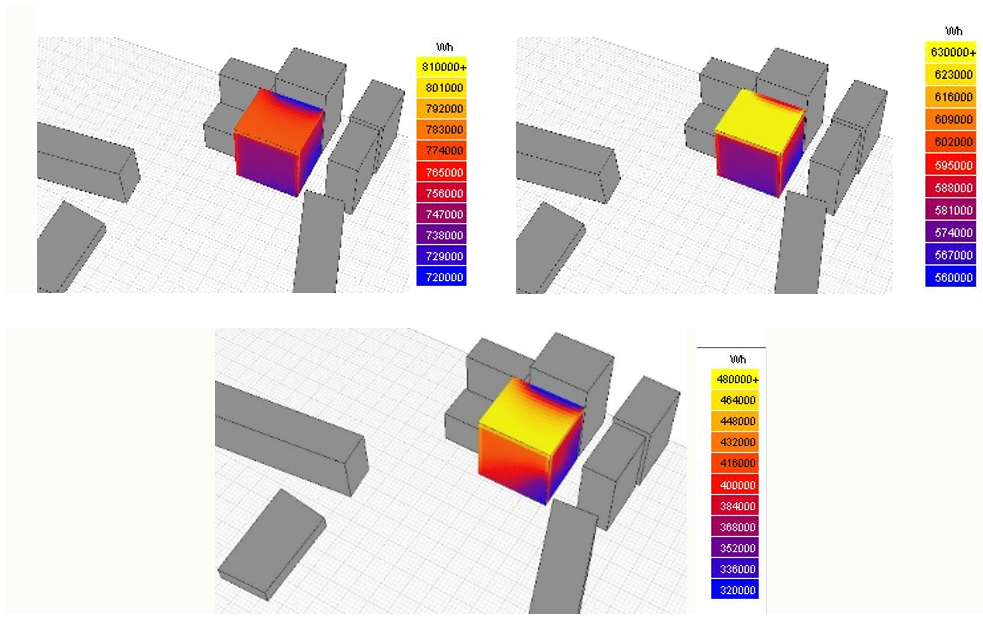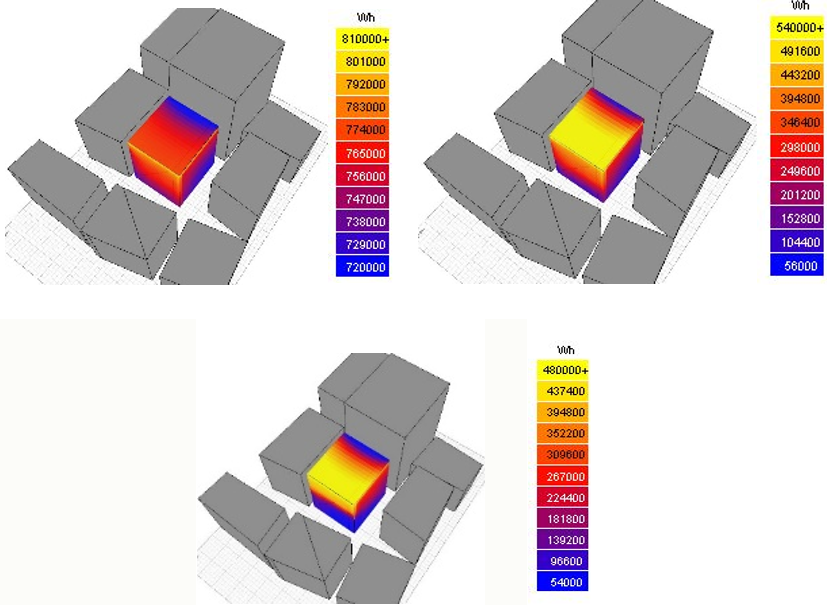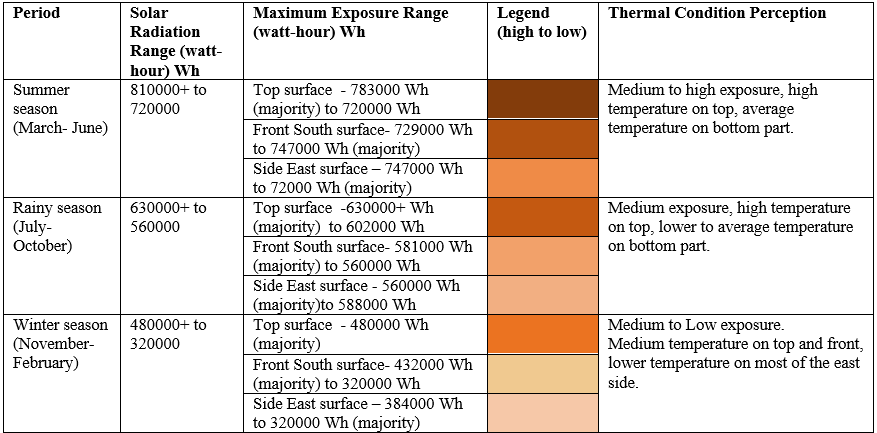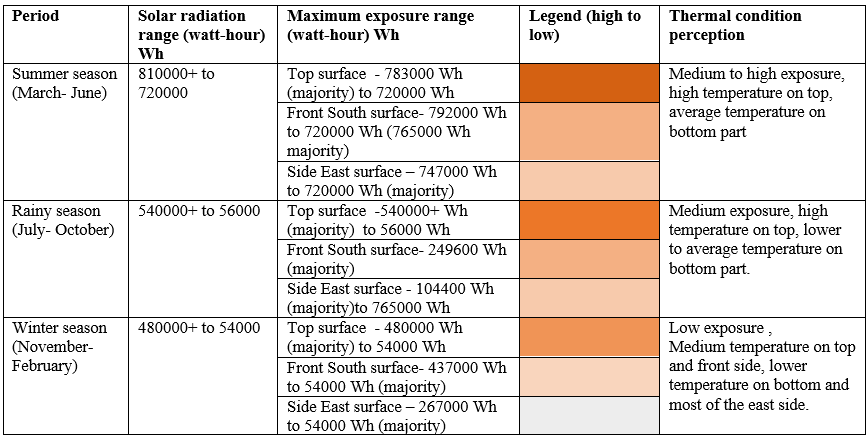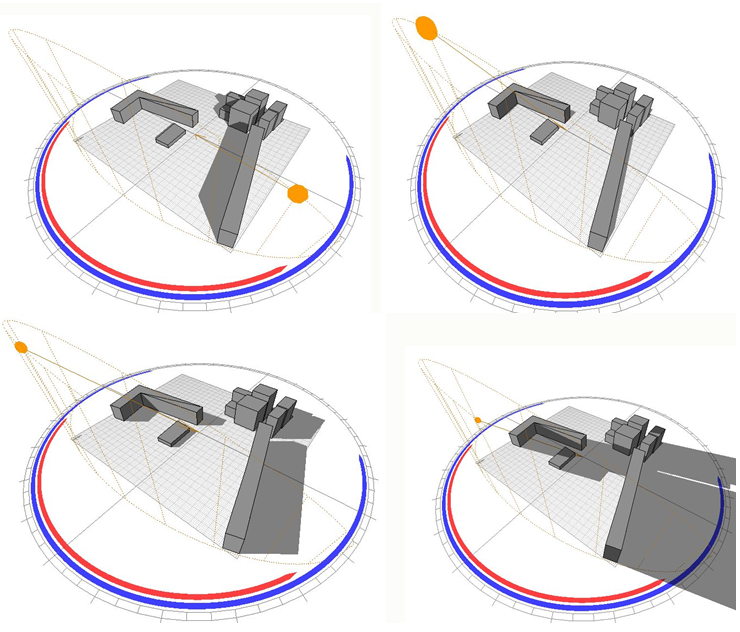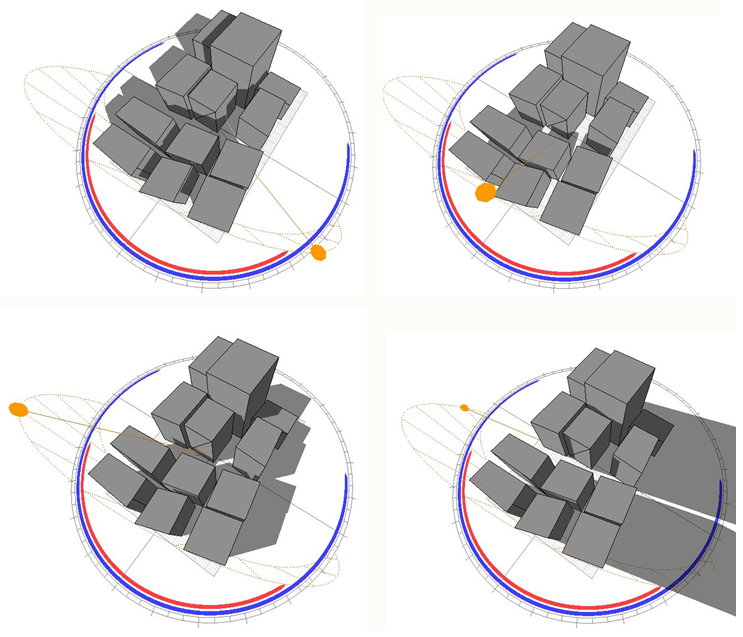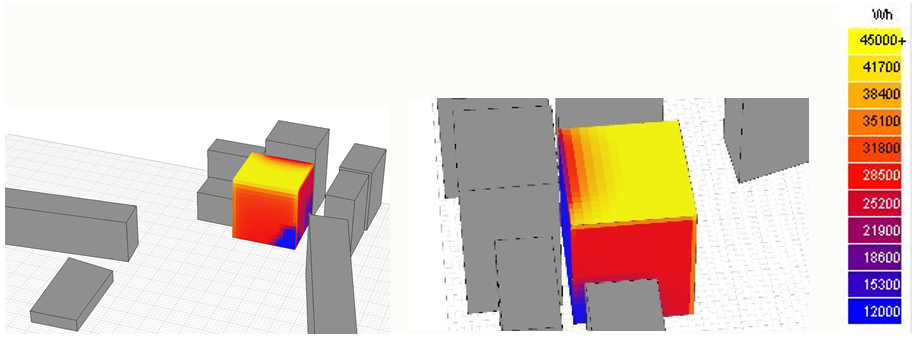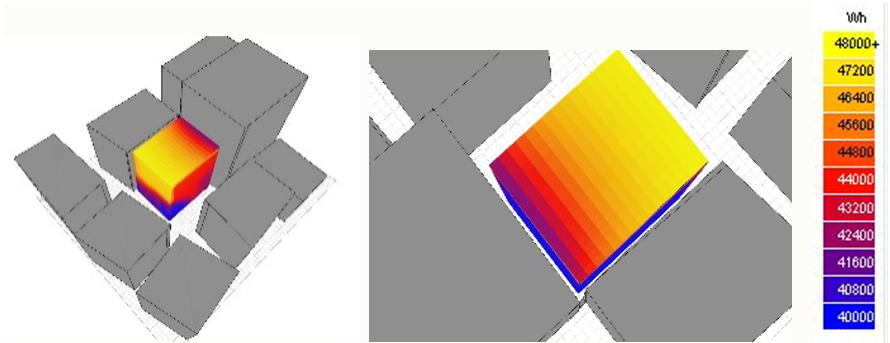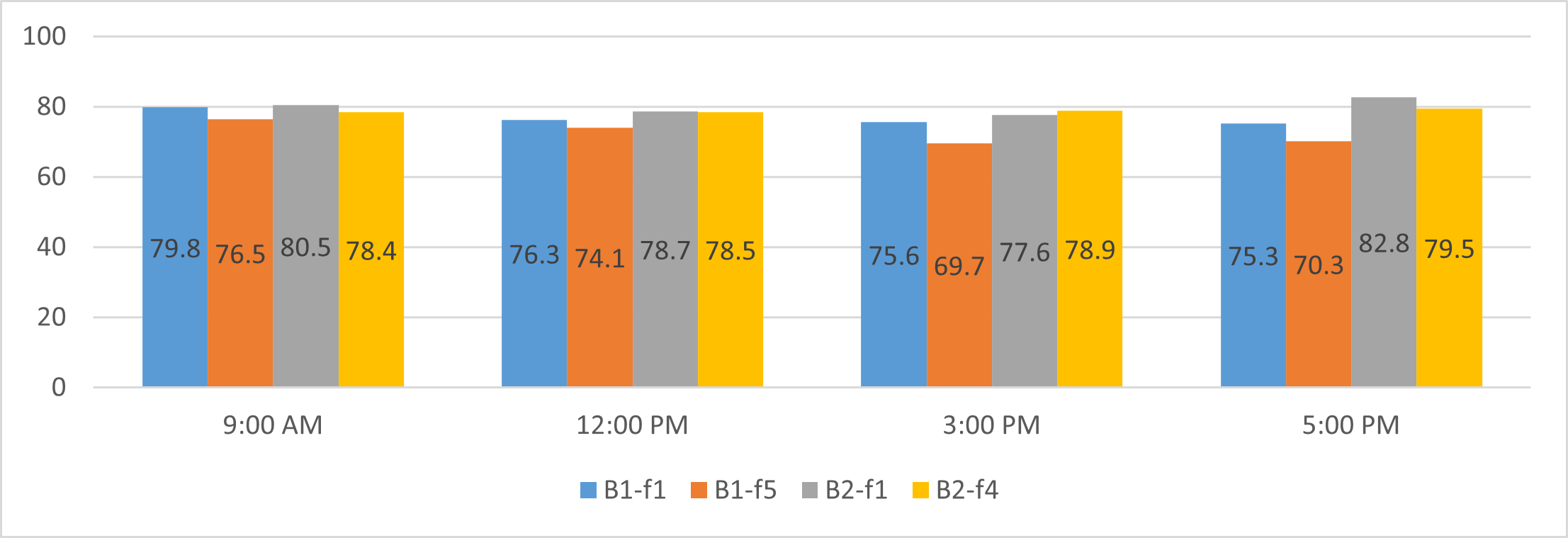Comparative Analysis of Thermal Comfort in Residential Buildings: A Study of the impact of Urban Density, Height, and Layout Patterns in the Context of Dhaka
- Shahrin Sultana Sinthia
- 1141-1160
- Jun 23, 2024
- Urban and Regional Planning
Comparative Analysis of Thermal Comfort in Residential Buildings: A Study of the impact of Urban Density, Height, and Layout Patterns in the Context of Dhaka
Shahrin Sultana Sinthia
M.Arch, Department of Architecture, Bangladesh University of Engineering and Technology (BUET), Dhaka, Bangladesh.
DOI: https://doi.org/10.51244/IJRSI.2024.1105077
Received: 18 May 2024; Revised: 03 June 2024; Accepted: 07 June 2024; Published: 23 June 2024
ABSTRACT
The thermal environment of residential spaces significantly influences residents’ physical and emotional well-being, affecting daily activities and overall quality of life. With a growing global emphasis on sustainability, energy efficiency, and healthy living understanding how architectural and urban elements impact thermal comfort becomes crucial. This study focuses on Dhaka, Situated in a tropical monsoon climate, this context presents unique challenges for ensuring thermal comfort within structures. The research conducts a comparative analysis of two residential structures with different layout configurations but similar orientations, situated in diverse urban settings with varying levels of density, exposure and openings. Investigating the influence of urban density, adequate openings, shading within the plan layout, and vertical positioning of structures on residents’ thermal comfort, the study employs extensive field data collection, observation, questionnaire survey and simulation. The findings indicate that high-density residential areas offer advantages such as reduced direct heat intake and loss, yet may encounter challenges including limited natural ventilation and increased heat absorption, resulting in elevated indoor temperatures. Conversely, low-density areas with open spaces benefit from enhanced natural ventilation and reduced heat accumulation, leading to improved thermal comfort, particularly in hot and humid conditions. This paper underscores the significance of considering architectural and urban aspects in residential buildings in Dhaka’s context to ensure the thermal comfort and well-being of residents. By addressing these factors, designers and urban planners can contribute to creating healthier and more sustainable living environments amidst changing climatic conditions.
Keywords: Urban Density, Building Height, Architectural Layout, Thermal Comfort, Dhaka City.
INTRODUCTION
A. Background of the Study
Dhaka City has over 200 years of urbanization process and over 400 years of history. During this period, Dhaka grew to be one of the most densely populated cities in the world. (Mowla, 2014). Dhaka is a result of reckless rapid expansion without careful and adequate urban planning like some other cities around the world but the great problem arises due to its overpopulation rate. Dhaka’s population in 2023 is currently estimated at 23.3 million. Dhaka added 606,802 people 2022, an annual rate of change of 1.98%, making it one of the most densely populated areas in the world with a total area of 306.38 square kilometers and a population density of 23,234 people per square kilometer. The rapid population growth has led to unplanned urbanization, which has brought significant challenges to public health as the urban environment has become a breeding ground for various health risks .Dhaka, the capital city of Bangladesh, has a tropical monsoon climate, which is characterized by high temperatures, high humidity, and copious amounts of rain. The average annual temperature is 25.6 °C (78.1 °F), with a monthly average ranging from 19.6 °C (67.3 °F) in January to 30.6 °C (87.1 °F) in April. The average annual rainfall is 2,144 mm (84.4 in), with the majority of rain falling during the monsoon season from June to September.
A building serves as a structure, offering shelter, privacy, and a space imbued with both functionality and emotions. In the realm of urban planning, a residential building not only becomes an individual’s sanctuary but also influences the surrounding microclimate and environment. Its design elements such as roof structure, facades, and strategic placement of openings profoundly impact the indoor environmental conditions, directly affecting thermal efficiency. Thus, the physical form, appearance, location and orientation of a building significantly shape its ability to maintain comfortable indoor temperatures while harmonizing with its external surroundings. In recent years, Bangladesh has been gripped by scorching heat waves, with extreme temperatures. Currently, Dhaka is in the throes of an unprecedented heat wave, with temperatures soaring well above normal levels. Research indicates that in 2024 from March to May Dhaka experiences an average of 8.5 days of heat waves during the pre-monsoon months, with temperatures peaking at 40.2℃ in the city. High temperatures in Dhaka pose a significant challenge, often leading to overheating in buildings, especially those constructed with materials like concrete and brick that absorb heat. This overheating exacerbates discomfort, particularly affecting vulnerable residents. Compounded by high humidity, which inhibits the body’s ability to cool down through sweating, the risk of heat-related health issues escalates. Inadequate ventilation in many residential structures traps heat and moisture indoors, worsened by overcrowding and limited ventilation options. Dhaka’s Urban Heat Island (UHI) effect further elevates temperatures, making it particularly tough for low-income households without air conditioning to maintain comfortable indoor conditions.
This research paper delves into how factors like urban density, building height, and layout influence thermal comfort in residential structures within Dhaka’s unique climatic context. Understanding these dynamics becomes crucial due to the region’s distinct weather patterns and extreme temperatures. By analyzing these elements, the study aims to offer insights to urban planners and architects on improving residential thermal comfort in Dhaka.
B. Literature Review
Rapid urbanization is a global phenomenon that is affecting people’s lives in different ways. As per the most recent demographic data provided by the United Nations, the current global urbanization rate stands at 54%, and it is projected to increase to 66% by the year 2050. Rapid urbanization allows for improved living standards and reduced energy consumption, but it also poses several risks, especially in developing countries (Global risk, 2023). One of the significant risks of rapid urbanization is the impact on the urban thermal environment, which affects the living standard and residential building design and it has recently attracted a lot of scholarly interest (Alfano et al., 2017; Parsons, 2014; Gilani, 2015; Yang et al., 2018). The issues surrounding the thermal environment have broad ramifications that impact many aspects of urban life and human existence. The temperature climate also contributes to air pollution worries, adding a worry for the environment to the problems (Mahadevia et al., 2020). The effects of building density, layout, and height on the indoor thermal environment have been the subject of several studies. In order to create a secure and comfortable living environment, residential structures are required. Overheating is a result of climate change that can have detrimental effects on people’s health and productivity because of prolonged exposure to heat (Aqilah et al., 2022). According the assessment of thermal comfort studies conducted in Indian residential structures, a number of variables, including building height, density, and layout, are very important in influencing thermal comfort. Taller structures are frequently chosen in fast urbanizing places like Dhaka, which has a big influence on the urban thermal environment. According to several research, the thermal comfort of residential buildings may be negatively impacted by rising air temperatures brought on due to higher building heights. (Sharmin et al., 2015). High building density is a common tendency in quickly urbanizing locations like Dhaka, according to Kakon et al. (2009). This might negatively affect the thermal comfort of residential structures. It is well-recognized that high building densities boost temperatures, which can be uncomfortable in residential buildings. Thermal comfort in tall buildings may be problematic, especially in densely populated areas. High-rise structures in Dhaka may be damaging to residents’ thermal comfort. These structures are vertical, hence there may be significant temperature differences between floors, with higher levels experiencing hotter interiors (Sarma, 2009). In addition to increasing discomfort, high-rise buildings may absorb more heat. Higher floors, where heat accumulation is more common, might be more unpleasant due to the vertical temperature differential in these buildings (Chan et al., 2008). Although high-density buildings may absorb less heat directly, they are more likely to absorb more heat indirectly due to inadequate natural ventilation (Yang et al., 2018). Thus, internal temperatures may rise to intolerable levels. Their layout and architecture greatly influence thermal comfort in residential structures. Heat dissipation might be impeded by inadequate space or incorrect orientation that blocks natural ventilation.
C. Objective of the Research
The objective of this research is to assess the impact of urban context, density, building height, and layout on the indoor thermal conditions in the hot and humid climate of Dhaka. The study aims to elucidate the critical role of urban planning and density in regulating the microclimate of residential areas. It will examine how factors such as building layout, outdoor exposure, orientation, and functional positioning influence the thermal environment, ventilation, and lighting within residential spaces, ultimately affecting resident comfort and energy consumption. This research underscores the importance of meticulous urban planning and building design to achieve comfortable living environments. By exploring these elements, the study seeks to offer practical recommendations for architects and urban planners to improve building designs, ensuring adaptability to future urban growth while promoting healthier and more comfortable living conditions. The ultimate goal is to develop strategies that foster sustainable urban development and enhance the overall quality of life in densely populated cities.
METHODOLOGY
A. Study Area Selection
The critical divergence between these selected sites is in the surrounding building density. The area is Khilgaon taltola, South City Corporation, ward01. One of the chosen buildings is situated in a low-density area, providing relatively more open space around it. Conversely, the second building is located in a notably high-density setting with significantly less open space. Furthermore, there is a variation in the building height between these two structures, with one being 6 stories tall and the other 5 stories in height both having south-east typically open but their exposure to environmental factors differs due to the distinct urban densities.
Fig.01 (1) The study area and selected building location on site, (2) Building 01,(2) Building02 (Source:Author,2023).
B. Data Collection
In this research, both qualitative and quantitative data were analyzed, with a main focus on primary data. Secondary data was gathered through a literature review of articles, papers, websites, books, and official documents to provide context and background for the study. The researcher utilized 3D visualizations and total thermal radiation analysis tools for simulation purposes. Field data collection involved using instruments to measure temperature and relative humidity in the selected survey areas. For both field data and questionnaire surveys, flats from the southeast corner of the selected buildings were chosen due to their exposure to more variables compared to opposite sides. To avoid additional thermal loads and conditions, flats below the top floor and above the ground floor were selected. Additionally, a questionnaire survey and one-on-one interviews with residents were conducted to gather their opinions and perceptions of the thermal conditions in their residential area. Data for the questionnaire survey were collected from in-house residents of the two buildings, with a sample size of 15, including a diverse range of ages and genders, as thermal comfort perception can vary based on individual acceptance, adaptability, and physical condition.
C. Variables of the Research
For this research, a selected set of variables were explored. Regarding the impact of urban context on thermal conditions, surrounding building density, height, and open space exposure were examined. In terms of building form, variables such as building height, orientation, floor plan configuration, and functional zoning were considered. For assessing indoor thermal conditions, indoor air temperature (Ta) and relative humidity (RH%) were measured. The questionnaire survey included variables such as occupancy, age, gender, and activity patterns.
D. Modelling & Simulation
To understand the urban context and building conditions, 3D models of both buildings and their surroundings were created using current maps and SketchUp software. These models were then analyzed in Ecotect version 05 for shadow analysis and total solar radiation on the building surface area. This approach helped to assess the impact of urban density and building height on the thermal conditions of indoor spaces.
E. Instrument
For field data collection, the Zeal Thermo-Hygrometer model PH1100 was used to measure relative humidity and temperature in the study area. This instrument features a digital display that provides clear and easy-to-read readings. It can measure humidity in the range of 10% to 99% relative humidity (RH%) and temperature in the range of -50 to 70 degrees Celsius (-58 to 158 degrees Fahrenheit), with a high resolution of 0.1 degrees Celsius or Fahrenheit. The Thermo-Hygrometer utilizes a built-in sensor to measure humidity and temperature accurately and includes a 12/24-hour clock for timekeeping.
F. Field survey Method
The physical data collection period spanned from October 10th to October 19th, 2023, encompassing a total of 10 days. Measurements were consistently taken in both buildings at approximately the same times each day, ensuring uniformity and comparability of data. Data collection commenced at 9 am each day, followed by subsequent measurements at 12 pm, 3 pm, and 5 pm. To ensure accurate readings, the Thermo-Hygrometer instrument was strategically positioned within the rooms, ideally at the central location when feasible, and positioned at a height of 1.5 meters from the floor. Additionally, at each measurement point, a two-minute waiting period was observed to allow for stable and precise data input. For research, purpose demark the four apartments as B1-f1 (Building 1, 1st floor), B1-f4 (Building 1,5th floor), situated in less dense area, B2-f1 (Building 2, 1st floor), B2-f3 (Building 2, 4th floor), situated in dense area (Fig.2). For the questionnaire survey of the residents, five structured questions were asked. These questions generally addressed their perceptions of thermal comfort, working conditions, natural lighting, and ventilation.
Fig. 2 (Left) Building 01(B1) typical floor plan; (Right) Building 02(B2) typical floor plan (Source: Author, 2023).
RESULTS
A. Results of Seasonal Thermal Simulation
The simulation, conducted using climatic data from Dhaka, focused on incident solar radiation on the study building surfaces across three main seasons: summer (March-June), characterized by hot and humid conditions; the rainy season (July-October), characterized by hot and wet conditions; and winter (November-February), characterized by cold and dry conditions. The average data from the study area, illustrated in Fig. x, Fig. y, Table z, and Table t, demonstrate that Building 01, which is situated in a low-density area with more open exposure, receives more solar radiation than Building 02, located in a high-density area with less open exposure, across all seasons.
This increased solar radiation exposure in Building 01 results in higher indoor temperatures during both the summer and rainy seasons. However, during the winter season, Building 01 remains warmer than Building 02, making the indoor areas more comfortable. Consequently, there is an increased use of active cooling systems in Building 01 during the summer and rainy seasons compared to Building 02. Conversely, Building 02 requires more heating during the winter season than Building 01.
Fig. 3 (Left) Total Solar ration on building surface (Building 01) in summer season (1); rainy season (2); winter season (3) (Source: Author, 2023).
Fig. 4 (Right)Total Solar ration on building surface (Building 02) in summer season (1); rainy season (2); winter season (3) (Source: Author, 2023).
Table.01 Solar radiation analysis on different season of study Building 01 (Source: Author, 2023).
Table.02 Solar radiation analysis on different season of study Building 02 (Source: Author, 2023).
The analysis reveals that Building 01, with its greater open exposure and optimal orientation, exhibits a consistently warm south (front) surface due to direct solar exposure. Meanwhile, the eastern side of Building 01 experiences moderate to low warmth from top to bottom, which can be attributed to its orientation and exposure patterns. In contrast, Building 02, characterized by limited open exposure and different orientation, shows high temperatures on the upper parts and lower temperatures on the bottom parts and east side across almost every season.
These findings indicate that despite the higher solar radiation exposure, the thermal conditions within each flat in Building 01 vary significantly. These variations are influenced by differences in height and the orientation of functional zones, impacting natural ventilation and lighting within the indoor spaces. For instance, the upper floors receive more sunlight, leading to higher indoor temperatures, which in turn necessitates the use of cooling systems. In the lower floors, the shading from surrounding structures results in lower temperatures, enhancing comfort during the hotter months but possibly requiring additional heating during colder periods.
Similarly, in Building 02, flats on the lower portions of the building face cooler temperatures compared to those on the upper levels. The limited open exposure and higher density around Building 02 reduce the amount of direct solar radiation, leading to a lower overall thermal gain. However, the upper floors, with less shading and more exposure, experience higher temperatures, especially in summer and rainy seasons, leading to a higher reliance on mechanical cooling systems.
Table.03 Solar radiation differences in study buildings (Source: Author, 2023).
| Category | Summer season | Rainy season | Winter season |
| Building 01 (B-01) | 783000 Wh to 720000 Wh | 630000 Wh to 560000 Wh | 480000 Wh to 320000 Wh |
| Building 02 (B-02) | 774000 Wh to 720000 Wh | 540000 Wh to 56000 Wh | 480000 Wh to 54000 Wh |
| Differences | Max – 9000 (+) Wh(B-01) | Max -90000 (+) Wh(B-01) | Max -0 Wh |
| Mini-0 Wh | Mini- 504000 (+) Wh(B-01) | Mini- 266000 (+) Wh(B-01) |
The comprehensive study will be substantiated through detailed solar radiation simulation analysis, field studies conducted over consistent time periods, and extensive questionnaire surveys. These methods will provide an understanding of the thermal environment, including factors such as indoor air temperature (Ta), relative humidity (RH), and the impact of urban density and building design on indoor thermal comfort. All these aspects will be elaborated on in the upcoming sections.
B. Results of Thermal Simulation
The simulation, conducted using climatic data from Dhaka, focused on incident solar radiation and shadow analysis on building surfaces. Both study areas were examined from October 10th to 19th, maintaining the same period. The shadow analysis illustrates the impact of different urban settings and building heights on shading, shadow effects, and sky view factor (SVF) on building surfaces. Various shadow analysis results are shown below in Fig.5 & Fig.6 .
In low urban density areas with large open exposures, buildings receive increased direct solar radiation, enhancing natural lighting, ventilation, and airflow. This, in turn, influences relative humidity, as depicted in the fig. Conversely, in high-density urban areas with limited open space, buildings receive less direct radiation due to significant shadow casting, low sky view factor (SVF), reduced natural light, and ventilation, resulting in increased relative humidity
Fig.5 Shadow analysis of Study area 01, Building 01, low urban density, from left -(top)9 am, 1 pm,(bottom) 3 pm, and 5pm (Source:Author,2023).
Fig.6 Shadow analysis of Study area 02, Building 02, low urban density, from left -(top)9 am, 1 pm,(bottom) 3 pm, and 5pm (Source:Author,2023).
The solar radiation analysis (Fig.7) measured in watt-hours (Wh) demonstrates the following for Building 01, radiation exposure ranges from 12,000 to 45,000+ Wh. The south side, which is fully open, ranges from 12,000 to 318,000 Wh, with predominantly medium to high exposure. The east side, with moderate open exposure, ranges from 12,000 to 21,900 Wh, and the west side, with extensive open exposure, ranges from 12,000 to 28,500 Wh. The north side, being fully blocked, shows only lower exposure levels. This highlights how low-density urban settings, larger open spaces, surrounding building shadows, building height, location, and orientation significantly impact a building’s thermal conditions. The southeast side of Building 01 shows more comfortable conditions compared to the southwest, and the lower portions of the building receive less radiation than the upper portions.
In contrast, Building 02 exhibits radiation exposure ranging from 40,000 to 48,000+ Wh (Fig.8). The south side, with minimal open exposure, ranges from 4,000 to 48,000 Wh, with the lower portions having less exposure and the upper portions more. The east side, with minimal open exposure, ranges from 40,000 to 44,000 Wh, while the west and north sides, being completely blocked, show consistently low exposure of 40,000 Wh. This indicates that high-density urban settings with minimal open space, significant shadowing from surrounding buildings, building height, location, and orientation result in a narrower range of thermal conditions. These findings underscore the critical role of urban density, open space availability, surrounding building shadows, building height, location, and orientation in influencing a building’s thermal environment.
Fig.7 Total Solar ration on building surface (Building 01) (Source: Author, 2023).
Fig.8 Total Solar ration on building surface (Building 02) (Source: Author, 2023).
C. Results of Field Survey
The field survey justify the data found in simulation analysis. South-east side was chosen and data collected from the four flats includes simultaneous measurements of indoor air temperature (Ta) and relative humidity (RH). The time-dependent averages data are displayed in Table 04; Table 05.
Table.04 B1 Building average Ta (Temperature) and RH (Relative Humidity) of study area on specific time (Source: Author, 2023).
| Time | Location | Ta of B1-f1 (Co) | RH% of B1-f1 | Ta of B1-f5
(Co) |
RH% of B1-f5 | Ta Difference
(+increase,- decrease) |
RH difference
(+increase,- decrease) |
| 09: 00 am | Bed room1 (south-east) | 31.8 | 78 | 32.1 | 74 | +0.3 | -04 |
| Bed room 2 (south-west; (blocked) | 31.5 | 80 | 31.6 | 76 | +0.1 | -04 | |
| Kitchen (east) | 31.5 | 77 | 31.8 | 75 | +0.3 | -02 | |
| Dining (central) | 31.2 | 82 | 32.0 | 78 | +0.8 | -04 | |
| Living room (south-west; (blocked) | 31.2 | 82 | 32.1 | 79 | -0.1 | -03 | |
| Bed room 3 (north,(blocked)-east) | 31.1 | 80 | 31.8 | 77 | +0.7 | -03 | |
| 12: 00 pm | Bed room1 (south-east) | 32.1 | 74 | 32.7 | 72 | +0.6 | -02 |
| Bed room 2 (south-west; (blocked) | 32.2 | 76 | 32.3. | 76 | +0.1 | 00 | |
| Kitchen (east) | 32.0 | 76 | 32.3 | 74 | +0.3 | -02 | |
| Dining (central) | 31.7 | 77 | 32.0 | 74 | +0.3 | -03 | |
| Living room (south-west; (blocked) | 31.9 | 79 | 32.4 | 75 | +0.5 | -04 | |
| Bed room 3 (north,(blocked)-east) | 31.5 | 76 | 31.9 | 74 | +0.4 | -02 | |
| 03: 00 pm | Bed room1 (south-east) | 31.1 | 73 | 31.4 | 68 | -0.1 | -05 |
| Bed room 2 (south-west; (blocked) | 31.3 | 75 | 31.4 | 70 | +0.1 | -05 | |
| Kitchen (east) | 31.5 | 74 | 31.4 | 69 | -0.1 | -05 | |
| Dining (central) | 31.7 | 77 | 31.5 | 71 | -0.2 | -06 | |
| Living room (south-west; (blocked) | 31.7 | 77 | 31.6 | 71 | -0.1 | -06 | |
| Bed room 3 (north,(blocked)-east) | 31.6 | 78 | 31.3 | 69 | -0.3 | -09 | |
| 05: 00 pm | Bed room1 (south-east) | 31.0 | 74 | 30.7 | 70 | -0.3 | -07 |
| Bed room 2 (south-west; (blocked) | 31.0 | 75 | 30.9 | 73 | -0.1 | -02 | |
| Kitchen (east) | 31.3 | 74 | 31.0 | 73 | -0.3 | -01 | |
| Dining (central) | 31.7 | 77 | 31.2 | 75 | -0.5 | -02 | |
| Living room (south-west; (blocked) | 31.7 | 77 | 31.2 | 75 | -0.5 | -02 | |
| Bed room 3 (north,(blocked)-east) | 31.5 | 75 | 31.2 | 74 | -0.4 | -01 |
Table.05 B2 Building average Ta and RH of study area on specific time (Source: Author, 2023).
| Time | Location | Ta of B2-f1 (Co) | RH% of B2-f1 | Ta of B2-f4
( Co) |
RH% of B2-f4 | Ta Difference
(+increase,- decrease) |
RH difference
(+increase,- decrease) |
| 09: 00 am | Bed room1 (south-east) | 29.9 | 80 | 30.5 | 79 | +0.6 | -01 |
| Bedroom 2 (north-east; (blocked) | 30.0 | 81 | 30.1 | 81 | +0.1 | 00 | |
| Kitchen (east) | 29.9 | 80 | 30.2 | 78 | +0.3 | -02 | |
| Dining (central) | 29.9 | 81 | 30.1 | 77 | +0.2 | -04 | |
| Living room (south-west; (blocked) | 29.9 | 80 | 30.3 | 77 | +0.5 | -03 | |
| 12: 00 pm | Bed room1 (south-east) | 30.9 | 77 | 31.2 | 78 | +0.3 | +01 |
| Bedroom 2 (north-east; (blocked) | 30.8 | 80 | 31.1 | 81 | +0.3 | +01 | |
| Kitchen (east) | 30.7 | 78 | 30.9 | 78 | +0.2 | 00 | |
| Dining (central) | 30.8 | 79 | 31.0 | 77 | +0.2 | -01 | |
| Living room (south-west; (blocked) | 30.8 | 78 | 30.9 | 77 | +0.1 | -01 | |
| 03: 00 pm | Bed room1 (south-east) | 31.5 | 76 | 31.6 | 80 | +0.1 | +04 |
| Bedroom 2 (north-east; (blocked) | 31.5 | 78 | 31.5 | 82 | 00 | +04 | |
| Kitchen (east) | 31.4 | 78 | 31.4 | 79 | 00 | +01 | |
| Dining (central) | 31.4 | 78 | 31.4 | 78 | 00 | 00 | |
| Living room (south-west; (blocked) | 31.4 | 78 | 31.4 | 79 | 00 | +01 | |
| 05: 00 pm | Bed room1 (south-east) | 31.7 | 80 | 31.3 | 78 | -0.4 | -02 |
| Bedroom 2 (north-east; (blocked) | 31.8 | 82 | 31.3 | 79 | -0.4 | -03 | |
| Kitchen (east) | 31.6 | 83 | 31.3 | 79 | +0.3 | -01 | |
| Dining (central) | 31.6 | 84 | 31.7 | 80 | -0.4 | -03 | |
| Living room (south-west; (blocked) | 31.6 | 85 | 31.2 | 80 | -0.3 | -04 |
D. Impact of Urban Density on Thermal Environment
The surrounding building density significantly influences the indoor thermal environment of residential structures, directly affecting the amount of sunlight that reaches interior spaces. In high-density areas, characterized by tall structures like Building-02 (B2), shadows reduce direct sunlight exposure, resulting in lower indoor temperatures. These areas also often lack adequate ventilation and green spaces, trapping moisture and humidity, which can lead to discomfort and heat-related issues. Conversely, low-density areas with more spaced-out buildings like Building-01 (B1) have greater solar exposure, potentially increasing indoor temperatures. Sky View Factor (SVF) is lower in high-density areas due to the obstruction by tall buildings, reducing natural ventilation and increasing heat absorption, which raises indoor temperatures after a certain time of day. In high-density settings, temperature (Ta) initially declines due to architectural shadows and reduced direct solar radiation, causing uneven relative humidity (RH). However, extremely high building densities hinder general ventilation and heat dissipation, eventually raising Ta and reducing human comfort. Below is a comparison chart of temperature (Ta) and relative humidity (RH) for both buildings.
Chart 01. Comparison of the daily average temperature of B1 and B2 on different time (Source: Author, 2023).
Chart 02. Comparison of the daily average Relative Humidity of B1 and B2 on different time (Source: Author, 2023).
The provided chart illustrates the distinct thermal behaviors in low-density area B1 and high-density area B2 throughout the day. In the morning, B1, with its low building density and high solar exposure due to a high Sky View Factor (SVF), experiences a rapid temperature rise and relatively higher humidity levels. As the day progresses, increased airflow in B1 leads to a temperature decline and reduced relative humidity. Conversely, B2, characterized by high-density surroundings and shading from taller buildings, initially has lower indoor temperatures. However, B2’s temperature and relative humidity gradually increase as the day progresses due to limited airflow and heat retention, resulting in less comfort later in the day. These observations highlight the significant impact of building density on indoor thermal conditions, influencing hours of comfort and discomfort. This understanding is crucial for creating healthy and comfortable living environments, emphasizing the importance of architectural considerations in urban planning to mitigate these effects and improve overall living conditions
E. Impact of Building Height on Thermal Environment
Building height influences the thermal environment by regulating solar access and shading. In high-density areas, tall buildings limit direct sunlight, advantageous for cooling in hot weather. Conversely, low-density areas with shorter buildings receive more sunlight, potentially reducing heating needs in colder seasons. Taller buildings can create wind channels, altering ventilation patterns and affecting temperature distribution. In high-density settings like Building-02 (B2), tall buildings cast shadows, lowering indoor temperatures, while in low-density areas like Building-01 (B1), fewer structures allow for increased solar exposure, leading to higher indoor temperatures. Additionally, there’s a natural temperature gradient in buildings, with lower levels cooler than upper levels, and ventilation patterns differ between floors. To study the effect of building height on thermal conditions, two apartments from each building were selected for comparison.
Chart 03. Comparison of the daily average temperature of B1 and B2 (Source: Author, 2023).
Chart 04. Comparison of the daily average RH of B1 and B2 (Source: Author, 2023).
The influence of building height on the thermal environment is closely linked to building density. In Chart 03, the highest daily average temperature is recorded on the 5th level of Building B1 (31.6°C) due to maximum direct sunlight exposure. Conversely, the 1st floor of the same building has a slightly lower temperature (31.5°C) due to reduced sunlight exposure and shading from roadside plantations. Sunlight influence is also seen in Chart 04, where the upper flat, B1-f5, has the lowest relative humidity (72.65%) due to better ventilation, while the lower flat, B1-f1, has higher humidity (76.75%) due to obstructions at road level and less effective ventilation.
In high-density areas, Chart 03 shows that the lower flat, B2-f1, has the lowest temperature (31.2°C) due to surrounding building shadows and the highest relative humidity (79.9%) due to limited ventilation. Conversely, B2-f4, located on the top level, has a lower temperature (31.3°C) and the second-highest relative humidity (78.3%), indicating better ventilation despite being in a high-density area.
F. Impact of Building Layout on Thermal Environment
The layout and orientation of residential buildings significantly impact airflow patterns and indoor thermal environments, especially in hot and sunny climates. Optimizing orientation relative to the sun’s path and prevailing wind direction is crucial. This involves minimizing east and west-facing windows to reduce direct sunlight exposure and maintain cooler indoor temperatures without excessive mechanical cooling. Window placement and size play vital roles in directing airflow for natural cooling, with cross-ventilation maximizing airflow through strategic window positioning. Architectural elements like shading devices, terraces, verandas, and thick outer walls further contribute to maintaining thermal balance. Careful planning and architectural considerations are essential for achieving optimal indoor thermal environments that enhance occupant well-being. Both buildings in the study are south-facing with southeast openings, differing in density. The thermal conditions are analyzed based on layout, orientation, openings, and surrounding density.
In order to compare the thermal conditions, four common building functions—bedroom 01, living, dining, and bedroom at the north—were photographed at two distinct times of day, 9 a.m. and 5 p.m. The following displays the thermal environment’s statistics data.
Chart 05. Ta of study area at 09.00 am (Source: Author, 2023).
Chart 05. Ta of study area at 05.00 pm (Source: Author, 2023).
The data reveals that at 9 am, flats in Building B1 typically experience high temperatures in all functional rooms, particularly Bedroom 01, with B1-f1 at 31.8°C and B1-f5 at 32.1°C. This is due to direct sunlight entering the rooms, compounded by the lower density of surrounding structures and the absence of effective shading solutions. Despite having a veranda, sunlight penetration remains significant, contributing to elevated temperatures. Additionally, the closed central layout limits ventilation and natural lighting in the dining area, while the living room lacks adequate airflow.
By 5 pm, temperatures in B1 flats typically decrease due to better ventilation compared to Building B2. The heat absorbed earlier in the day gradually radiates, leading to a more comfortable thermal condition. This cooling effect is particularly notable in Bedroom 01, with B1-f1 at 31.0°C and B1-f5 at 30.7°C, representing reductions of 0.8°C and 0.4°C, respectively, from the morning temperatures.
Conversely, Building B2 exhibits different temperature trends. Situated in a denser area, B2 benefits from a layout that prevents direct sunlight from reaching the bedrooms initially. The open layout in living and other rooms contributes to lower initial temperatures, such as B2-f1 at 29.9°C and B2-f4 at 30.5°C at 9 am. However, as the day progresses, limited ventilation and slow heat reduction processes cause temperatures to rise in B2, reaching B2-f1 at 31.7°C and B2-f4 at 31.3°C by 5 pm, each increasing by approximately 0.8°C. Consequently, the overall temperature within B2 flats becomes less comfortable compared to those in Building B1.
The influence of building density on temperature is evident. Building B1, with its less dense surroundings, experiences higher morning temperatures due to direct sunlight. In contrast, Building B2 benefits initially from the absence of direct sunlight due to denser surroundings, leading to lower morning temperatures. However, as the day progresses, the lack of ventilation and heat reduction processes cause B2’s temperature to rise, making it less comfortable overall.
G. Findings of User’s Interview
The comprehensive research primarily relied on the collection of primary quantitative data through on-site measurements and simulation. Additionally, fundamental interviews were conducted as part of the research methodology. These interviews served two main purposes: enhancing data analysis efficiency and facilitating a comparative assessment of instrument-derived data with users’ subjective experiences.
Residents in the study area had resided in the selected buildings for a minimum of 2 years, extending up to a maximum of 13 years. This range in tenure adds valuable depth to our research, as it allows for consideration of long-term implications of thermal conditions in residential buildings. It’s important to recognize that individuals’ experiences and perceptions may vary based on the length of their residence. Moreover, differences in standards for thermal comfort among residents may also arise due to individual preferences and living habits.
In summary, the findings from our interviews reveal the following Table 06 about the two buildings.
Table.06 Findings of interview (Source: Author, 2023).
| Category | Less | Moderate | More |
| Increased indoor temperature in summer | B- 02 | B-01 | |
| Cooler temperature in winter | B-01 | B- 02 | |
| Natural ventilation | B- 02 | B-01 | |
| Natural lighting | B- 02 | B-01 | |
| Need for active cooling system | B- 02 | B-01 | |
| Discomfort environment for working | B- 02 | B-01 |
B1 Building:
- Residents often feel uncomfortable, especially in the summer, with bedroom 01 being particularly prone to extreme heat. To address this discomfort, they frequently resort to using air conditioning as a solution.
- The situation improves at night when the temperature drops, and the openness of the building allows for better airflow, creating a more comfortable environment.
- Challenges are faced in the dining area due to insufficient natural lighting and ventilation.
- Until the new construction on the north side, the living room had excellent ventilation and comfortable lighting. However, at present, residents encounter ventilation issues in this area.
- In winter this building has a cool and comfortable environment.
B2 Building:
- Bedroom01 in the B2 building tends to be cooler during the early part of the day, primarily because it receives less direct sunlight.
- Residents often contend with issues related to proper ventilation and adequate lighting.
- The humidity within the building appears to be higher, which contributes to a less comfortable environment.
- In winter this building has a cooler environment.
In summary, the varying experiences of residents in these two buildings underscore the importance of considering individual needs and habits when evaluating thermal comfort. Additionally, architectural features like openness, lighting, and ventilation significantly impact residents’ perceptions of their living environments.
DISCUSSIONS
The investigation highlights significant differences in thermal behaviors between low-density (B-01) and high-density (B-02) buildings. In B1 Building (Low-density area), temperatures rise rapidly in the morning due to high solar exposure but decline later as airflow improves. B-02 Building (High-density area) starts with lower morning temperatures but gradually warms throughout the day due to limited airflow. Humidity levels also vary between the two buildings, with B-01 exhibiting initially higher humidity that decreases as temperatures drop, while B-02 has consistently higher humidity levels, contributing to discomfort. Furthermore, in B-01 Building, the highest temperature is observed on the 5th level due to direct sunlight exposure, while lower floors have slightly lower temperatures. In B-02 Building, the lower flat maintains the lowest temperature, benefiting from shading, whereas the upper flat enjoys better ventilation. These findings underscore the significant impact of building density on indoor thermal conditions. They emphasize the importance of architectural considerations in urban planning to create comfortable living environments for residents.
LIMITATIONS AND FUTURE SCOPE
A significant limitation of this research is its temporal scope, as field data collection was confined to October, representing only the rainy season, and did not account for variations across other seasons. This restricted timeframe may not fully capture the seasonal fluctuations and their impact on the thermal environment. Additionally, the short data collection period limits the comprehensiveness of the findings. Extending the data collection period to cover all seasonal variations would provide a more strong understanding of the thermal conditions and enhance the accuracy of the research outcomes. This comprehensive approach would better support the research objectives. Furthermore, the study predominantly focused on specific factors like building height, density, and layout while omitting a range of influential elements, including building materials, potential heat-generating activities, and various thermal indicators like air temperature (Ta), surface land temperature, mean radiant temperature, and parameters related to thermal comfort, impacts of green plantation ,building form and shape etc. These unaddressed factors could significantly enhance the precision of characterizing the thermal environment in residential areas. Additionally, the research explored only two types of building layouts and urban densities. To achieve more comprehensive findings, it would be beneficial to examine various urban densities, different building layouts, and different locations. This broader approach would provide a wider range of variables and yield more significant and valuable insights. This limitation underscores the potential for future comprehensive research endeavors that extend across seasons and consider a wider array of variables, ultimately offering a more nuanced understanding of thermal conditions and paving the way for effective strategies to optimize indoor comfort and living conditions in diverse contexts through proper urban planning and responsive architectural practice.
RECOMMENDATIONS
In the above situation, it is essential to make vital recommendations to address issues related to building height, location, density, and layout to improve indoor living conditions and increase comfort. Post Occupancy Evaluation (POE) is essential for determining how well the architects have met a range of user criteria. Governmental organizations should conduct POEs regularly to get updated input from residents. Then, using this useful knowledge, design concepts and technology may be improved with more efficacy (Sarma, 2009). Architects should plan buildings while considering the potential maximum development in the vicinity, taking into account urban density and potential future scenarios. This approach ensures that buildings remain well-suited to their evolving urban landscapes (Mann, 1992; Yung et al., 2018; Terrapin Bright Green, 2023). According to the Environmental Protection Agency (EPA), indoor air pollution can often be two to five times higher than outdoor levels. In such cases, it is advisable to employ traditional ventilators placed at elevated levels or ventilation ducts that extend vertically, connecting confined spaces for the efficient removal of hot and stagnant air. These strategies can contribute significantly to enhancing indoor air quality (Sarma, 2009). Traditional guideline of “aligning activity patterns with cardinal comfort locations” in certain situations should be followed. Architects should take into account passive design strategies, which use natural components to control indoor temperature. This include orienting the structure to maximize natural light and ventilation, storing and releasing heat using thermal mass, and adding shading mechanisms to filter out too much sunshine. High-density locations with little room for conventional heating and cooling systems can benefit greatly from passive design (Kwok and Grondzik, 2018). Different approaches to building form and shape, including optimizing the solid-void relationship, minimizing surface exposure to extreme solar radiation, and incorporating functional depth in plans, can significantly enhance thermal comfort. Effective natural ventilation through strategic zoning and planning is crucial. Implementing Floor Area Ratio (FAR) regulations, increasing green coverage, strategic plantation, and designing appropriate shading devices also play vital roles. Additionally, urban planning indirectly addresses thermal conditions by ensuring proper zoning, functional placement, maintaining adequate building density, and preserving open green areas in all zones. These factors are often underrated but are essential for improving thermal conditions and overall urban livability. A pivotal aspect of the design and planning process is actively involving the community. Seeking residents’ input ensures that new projects align with their needs and desires. This approach can lead to the creation of living spaces that are more user-centered and comfortable (Kabisch et al., 2017).
CONCLUSION
In conclusion, this research sheds light on the intricate relationship between urban density, building height, layout patterns, and the thermal comfort experienced in residential buildings, particularly in the context of Dhaka’s tropical monsoon climate. The study underscores the pressing need to address these factors comprehensively to enhance indoor living conditions and ensure the well-being of residents. Key findings highlight the significant impact of building density and height on solar exposure, natural ventilation, and relative humidity levels. Recommendations include conducting post-occupancy evaluations to continually improve design concepts, considering future urban growth in building planning, prioritizing indoor air quality enhancements, and leveraging smart building technologies for energy efficiency and comfort optimization. Additionally, passive design strategies and community-centric planning approaches offer promising avenues for creating more sustainable and user-centered living environments. By addressing these challenges and implementing forward-thinking design strategies, Dhaka has the potential to enhance the thermal comfort of its residential buildings, ultimately improving the quality of life for its residents and fostering a more sustainable urban environment.
ACKNOLEDGEMENT
The author expresses sincere gratitude to Atiqur Rahman, assistant professor, Department of Architecture at Bangladesh University of Engineering and Technology (BUET for his helpful guidance.
REFERENCES
- Aqilah, N., Rijal, H.B., & Zaki, S.A. (2022). A Review of Thermal Comfort in Residential Buildings: Comfort Threads and Energy Saving Potential. Energies, 15(23), 9012. https://www.mdpi.com/1996-1073/15/23/9012
- Chan, E. H. W., Lam, K. S., & Wong, W. S. (September 2008). Evaluation on indoor environment quality of dense urban residential buildings. Journal of Facilities Management, 6(4), 245-265. DOI: 10.1108/14725960810908127.
- Alfano, F.R., Olesen, B.W., & Palella, B.I. (2017). Povl Ole Fanger’s Impact Ten Years Later. Energy and Buildings, 152, 243–249.
- Gilani, S.I.U.H., Khan, M.H., & Pao, W. (2015). Thermal Comfort Analysis of PMV Model Prediction in Air Conditioned and Naturally Ventilated Buildings. Energy Procedia, 75, 1373–1379. https://doi.org/10.1016/j.egypro.2015.07.218
- Kabisch, N., & Haase, D. (2017). Green Justice or Just Green? Provision of Urban Green Spaces in Berlin, Germany. Landscape and Urban Planning, 164, 124-139. DOI: 10.1016/j.landurbplan.2013.11.016
- Kwok, A. G., & Grondzik, W. T. (2007). The Green Studio Handbook: Environmental Strategies for Schematic Design. Enquiry The ARCC Journal for Architectural Research, 4(2). https://doi.org/10.17831/enq:arcc.v4i2.47
- Kakon, A. N., Mishima, N., & Kojima, S. (2009). Simulation of the urban thermal comfort in a high density tropical city: Analysis of the proposed urban construction rules for Dhaka, Bangladesh. Building Simulation, 2(4), 291-305. DOI: 10.1007/s12273-009-9321-y.
- Mahadevia, D., Pathak, M., Bhatia, N., & Patel, S. (2020). Climate Change, Heat Waves and Thermal Comfort—Reflections on Housing Policy in India. Environment and Urbanization ASIA, 11(1), 29-50. http://dx.doi.org/10.1177/0975425320906249
- Mann, T. (1992). Building Economics for Architects. John Wiley & Sons. ISBN: 978-0-471-28403-1
- Parsons, K. (2014). Human Thermal Environments: The Effects of Hot, Moderate and Cold Environments on Human Health, Comfort and Performance. CRC Press, Inc.
- Sarma, B.B. (2009). Post Occupancy Findings of Some Factors of Thermal Comfort in Residential High-Rise Buildings in Dhaka City of Bangladesh. Available at SSRN: https://ssrn.com/abstract=1433695 or http://dx.doi.org/10.2139/ssrn.1433695
- Sharmin, T., Steemers, K., & Matzarakis, A. (2015). Analysis of microclimatic diversity and outdoor thermal comfort perceptions in the tropical megacity Dhaka, Bangladesh. Building and Environment, 94. DOI: 10.1016/j.buildenv.2015.10.007.
- Terrapin Bright Green. (2023). 14 Patterns of Biophilic Design. Available online: https://www.terrapinbrightgreen.com/reports/14-patterns/
- United Nations. (2015). World Urbanization Prospects: The 2014 Revision; Population Division, Department of Economic and Social Affairs: New York, NY, USA.
- World Bank. (2018). Toward a Livable Dhaka. (Blog Post). Retrieved from https://blogs.worldbank.org/endpovertyinsouthasia/toward-livable-dhaka.
- Yang, Y., Zhang, X., Lu, X., Hu, J., Pan, X., Zhu, Q., & Su, W. (2018). Effects of Building Design Elements on Residential Thermal Environment. Sustainability, 10, 57. https://doi.org/10.3390/su10010057.
- The risks of rapid urbanization in developing countries, Global risks. (2023). https://www.zurich.com/en/knowledge/topics/global-risks/the-risks-of-rapid-urbanization-in-developing-countries
- https://www.dhakatribune.com/bangladesh/bangladesh-environment/344469/heatwaves-lingering-longer-in-bangladesh


